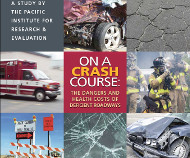Article from: www.thenewspaper.com/news/48/4869.asp
1/8/2016
2009 Study: Deficient Roads Kill More Than Speeding
Road building industry study from 2009 calculates the hazard of bad road conditions.
 Major cities around the country, including New York, San Francisco and Washington, DC, have adopted "Vision Zero" strategy of reducing traffic fatalities through lowered speed limits and increased ticketing. A 2009 study conducted on behalf of the road construction industry suggests the focus on speeding is disproportionate and far more lives would be saved by devoting resources to engineering improvements.
Major cities around the country, including New York, San Francisco and Washington, DC, have adopted "Vision Zero" strategy of reducing traffic fatalities through lowered speed limits and increased ticketing. A 2009 study conducted on behalf of the road construction industry suggests the focus on speeding is disproportionate and far more lives would be saved by devoting resources to engineering improvements.
"This is the first national study in many years to examine the role and consequences of another major factor in these tragic incidences -- the physical condition of U.S. roadways," researchers Ted R. Miller and Eduard Zaloshnja explained. "The study finds that the cost and severity of crashes where roadway conditions are a factor greatly exceeds the cost and severity of crashes where alcohol or speeding was involved, or the cost of non-use of seatbelts."
Miller and Zaloshnja are economists specializing in safety issues for the non-profit Pacific Institute for Research and Evaluation (PIRE). They looked at a database of 17 million traffic accidents across the nation in 2006 to calculate that deficient roads played a role in 52.7 of fatal incidents and 38 percent of injuries. The figures count accidents where cars hit large trees, collided with bridges or non-breakaway poles on the side of the road.
Such incidents represent a far greater share of accidents than drunk driving or exceeding the posted speed limit. The study stresses that not all of the proposed remedies to deficient roads are expensive or difficult to implement.
"These improvements include structural changes such as adding or widening shoulders, improving roadway alignment, replacing or widening narrow bridges, reducing pavement edges or drop offs, and providing more clear space in the area adjacent to roadways," the study explained. "Cost-effective, immediate solutions include using brighter, more durable pavement markings, installing better signage with easier-to-read legends, adding rumble strips, and using more guardrail or barrier where appropriate."
By contrast, Vision Zero focuses on "road diets" that narrow lanes and place obstacles in the way of motorists in an effort to slow traffic.
"Although driver factors are involved in most crashes, avoiding those crashes through driver improvement requires reaching millions of individuals and getting them to sustain best safety practices," the study concluded. "That is not fail-safe. It is far more practical to make the environment more forgiving and protective."
The report was commissioned by the Transportation Construction Coalition, a group led by the American Road and Transportation Builders and the Association and the Associated General Contractors of America, both of which have a substantial financial interest in enhanced spending on roads.
A copy of the report is available in a 1.2mb PDF file at the source link below.
Source: On a Crash Course: Dangers and Costs of Deficient Roadways (Pacific Institute Research and Evaluation, 5/1/2009)
Permanent Link for this item
Return to Front Page
 Major cities around the country, including New York, San Francisco and Washington, DC, have adopted "Vision Zero" strategy of reducing traffic fatalities through lowered speed limits and increased ticketing. A 2009 study conducted on behalf of the road construction industry suggests the focus on speeding is disproportionate and far more lives would be saved by devoting resources to engineering improvements.
Major cities around the country, including New York, San Francisco and Washington, DC, have adopted "Vision Zero" strategy of reducing traffic fatalities through lowered speed limits and increased ticketing. A 2009 study conducted on behalf of the road construction industry suggests the focus on speeding is disproportionate and far more lives would be saved by devoting resources to engineering improvements.